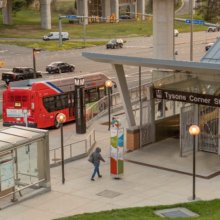What is Transportation Demand Management

Transportation demand management (TDM) is the successful complement to infrastructure.
TDM focuses on understanding how people make their transportation decisions and influencing people’s behavior to use existing infrastructure in more efficient ways, like reducing single occupancy vehicle trips and getting people to use transit, ridesharing, walking, biking, and telework. TDM is cost effective in guiding the design of transportation and physical infrastructure so that options other than driving are naturally encouraged and transportation systems are better balanced.
How is TDM implemented?
Information, Encouragement, Incentives
TDM is a program designed to help people know about and use all their transportation options to optimize all modes in the system and to counterbalance the incentives to drive that are so prevalent in subsidies of parking and roads.
Designing transportation and physical infrastructure
TDM is a principle that should guide everything we do in designing our transportation and physical infrastructure so that alternatives to driving are naturally encouraged and our systems are better balanced.
Traditional and innovative technology based services
TDM is a suite of services that encourage people to use transit, ridesharing, walking, biking, and telework. This includes building and maintaining partnerships with employers and comprehensive promotional programs.
What makes up a robust TDM strategy?
Mobility Lab believes there are seven basic parts of a robust TDM strategy that have the power to shift trips:
- Information
- Marketing business benefits to employers
- Comprehensive programs with mutually reinforcing services, such as transit, carpool/vanpool, bike, walk, transit stores
- Incentives for transit and alternate modes
- Disincentives for driving, which is where parking supply and pricing, tolls, and congestion pricing come in
- Ordinances and development conditions
- Trip caps or maximum average vehicle occupancy
Where do you see the impacts of TDM?



Measuring the benefits of TDM?
Learn how to estimate the benefits of your TDM program with the TDM ROI Calculator or planned expansions of service with TRIMMS 4.0. Both tools will be valuable additions to your evaluation methods.
Want to learn more about TDM?
As a transportation policy maker, funder, planner, TDM practitioner, employer, or real estate developer, quantifying costs and benefits of TDM programming to justify the investment and compare it to other transportation improvements can be complex. Here are some resources to help explain:
- List of the top TDM strategies
- 5 ways TDM is invisible (and why that should change)
- Rebranding “TDM” could fix the industry’s communications struggle
- TDM is not scary: A 101 on transportation demand management
- Inside Arlington County’s TDM Bureau
- Overview of Arlington County TDM Commuter Programs
- Victoria Transport Policy Institute’s TDM Encyclopedia
- Association for Commuter Transportation
- Center for Urban Transportation Research at the University of South Florida
- U.S. DOT Federal Highway Administration TDM Strategies
- And, of course, Wikipedia
Contact Us
The Mobility Lab team greatly appreciates your feedback.
If you would like to read our Express Newsletter featuring our latest TDM research and commentary sent directly to your inbox, click to Subscribe.
Mobility Lab
1501 Wilson Boulevard, Suite 1100
Arlington, Virginia 22209
703.228.6558